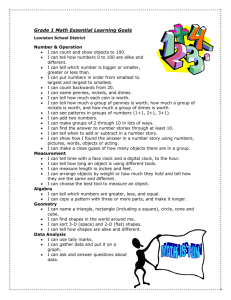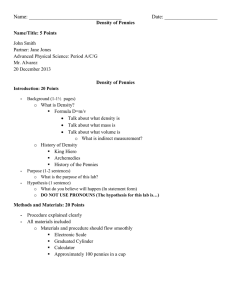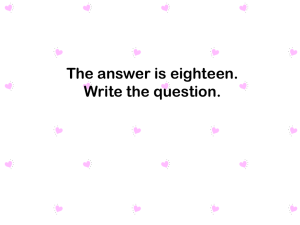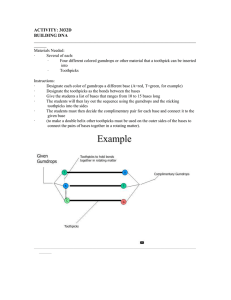Document 10519409
advertisement
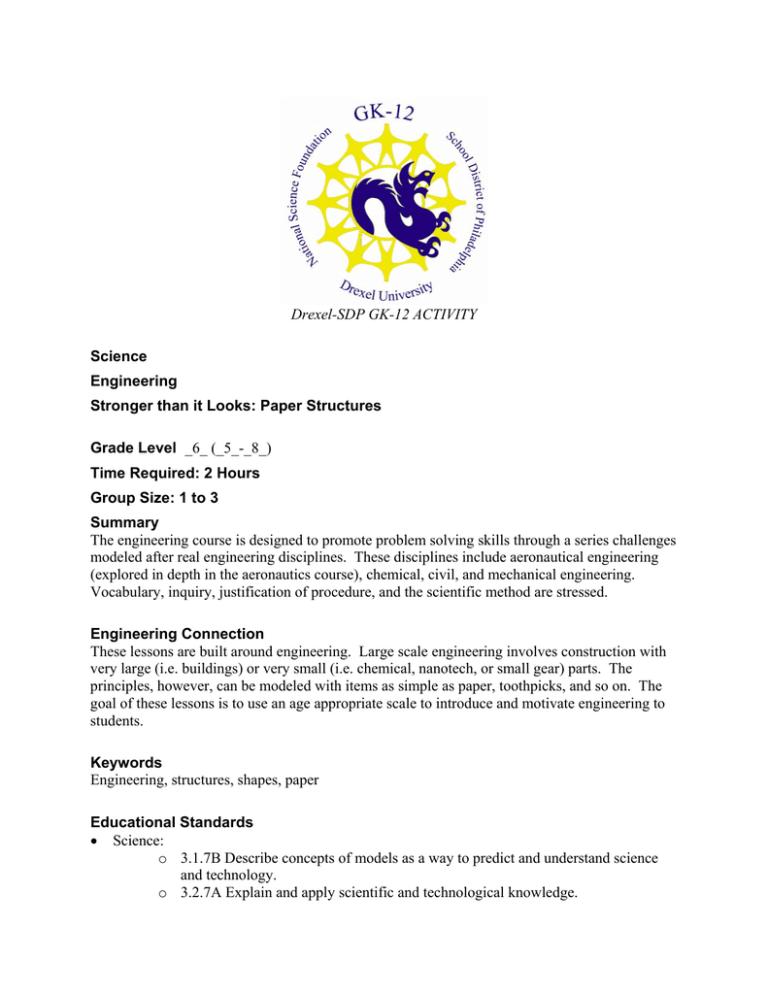
Drexel-SDP GK-12 ACTIVITY Science Engineering Stronger than it Looks: Paper Structures Grade Level _6_ (_5_-_8_) Time Required: 2 Hours Group Size: 1 to 3 Summary The engineering course is designed to promote problem solving skills through a series challenges modeled after real engineering disciplines. These disciplines include aeronautical engineering (explored in depth in the aeronautics course), chemical, civil, and mechanical engineering. Vocabulary, inquiry, justification of procedure, and the scientific method are stressed. Engineering Connection These lessons are built around engineering. Large scale engineering involves construction with very large (i.e. buildings) or very small (i.e. chemical, nanotech, or small gear) parts. The principles, however, can be modeled with items as simple as paper, toothpicks, and so on. The goal of these lessons is to use an age appropriate scale to introduce and motivate engineering to students. Keywords Engineering, structures, shapes, paper Educational Standards • Science: o 3.1.7B Describe concepts of models as a way to predict and understand science and technology. o 3.2.7A Explain and apply scientific and technological knowledge. o 3.2.7B Apply process knowledge to make and interpret observations. o 3.2.7C Identify and use elements of scientific inquiry to solve problems. o 3.1.7D Know and use the technology design process to solve problems. • Math: o 2.4.8A Make conjectures based on logical reasoning and test conjectures by using counter-examples. o 2.4.8C Use if…then statements to construct simple, valid arguments. o 2.5.8A Invent, select, use and justify the appropriate methods, materials and strategies to solve problems. o 2.5.8C Justify strategies and defend approaches used and conclusions reached. o 2.5.8D Determine pertinent information in problem situations and whether any further information is needed for solution. Learning Objectives After this lesson, students should be able to: • Identify shaped structures that hold up the most weight. • Apply the strong shaped structure to hold weight. Materials List • Straws or toothpicks • Gumdrops • Books • Index cards • Pennies (hundreds) • Scrap paper • Tape • Weight Introduction / Motivation One of the most important engineering tasks is to construct a structure that holds weight. We see examples of this every day: bridges, swing sets, and so on. The goal is to create a structure that can hold more weight than the sum of its parts. To do this, we’re going to have to be clever about how we put our structure together. At first glance, it may seem a bit intimidating to even make a structure stand on its own, let alone hold any weight – but today you will learn how it’s done. Vocabulary / Definitions Word Definition Dead Empty weight of the structure – the sum of its parts. Weight Live The amount of weight supported by the structure. Weight 2 Procedure Part 1 – Determining the strongest shape • Looking around you, try to predict what you think will and will not hold weight well. Make a list and indicate why you feel that way or what observation leads you to believe this. • Using the straws and gumdrops / marshmallows, create shapes that you think will hold the most weight. How would you change your predictions? • Write down what performed the best, and where you might see that shape used to support weight every day. Part 2 – Penny bridge • Using books, index cards, and pennies, place an index card between two books. • Make a design on paper that you think will work the best. • Construct shapes to support that index card. • Use pennies to see how much weight your index card can hold. Make changes until you think you’ve got the best. • Then, see if you can fold a single index card across the books to hold the same number of pennies. Hint: Think about the shapes that worked before! Does it hold even more? o Put your finger under each side of the index card and put weight in the center; notice how you feel that weight distributed such that you actually feel the card push against your finger. This keeps the index card stable on the surface! Part 3 – Strong Paper • Take a piece of paper and create shapes out of it until you get something that can hold up the weight of a book, or several books. • Every time you change something about your design, write it down and predict why your change will matter. References Jennifer Rickard: A Handbook of Science, Mathematics and Engineering Activities for 8-12 Year Olds. “Structures.” University of Arizona. Owner Drexel University GK-12 Program Contributors Bill Mongan, Jason Coleman, Copyright Copyright 2007 Drexel University GK12 Program. Reproduction permission is granted for nonprofit educational use Version: Mar 2007 3
